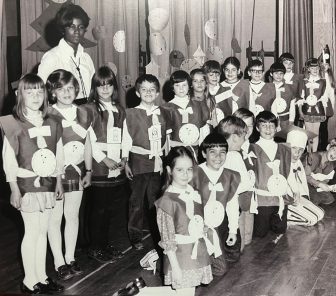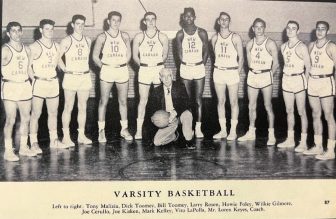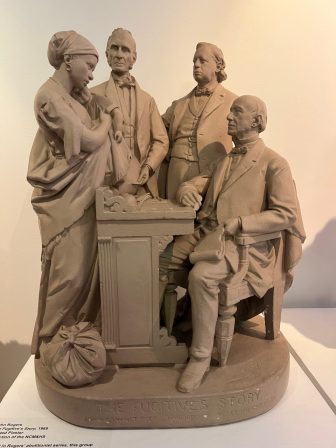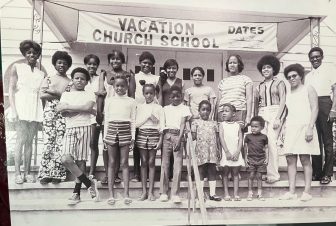A new exhibition two years in the making, “Forces of Change: Enslaved and Free Blacks in New Canaan,” opens Friday, March 3 at the New Canaan Museum & Historical Society at 13 Oenoke Ridge. We met with the organization’s executive director, Nancy Geary, to get some background and an overview of the widely anticipated exhibition.
Here’s a transcript of our interview:
New Canaanite: Give us an overview of the exhibition.

South School Play, 1972
Shirley Fitzgerald from Norfolk State College helped the second-grade class prepare for their play “Trouble in Tick Tock Town.”
Photo credit: New Canaan Advertiser, courtesy of the New Canaan Museum & Historical Society
Nancy Geary: The exhibition has had a number of titles. It’s now called ‘Forces of Change: Enslaved and Free Blacks in New Canaan.’ And starting when Canaan Parish had slaves, it tracks the life and work of Black residents in New Canaan. It will include documents from the early-1700s through to Stand Together Against Racism’s protest following the murder of George Floyd.
What is the origin of the exhibition?
The origin was that the New Canaan Museum & Historical Society partnered with the library and New Canaan Community Foundation and a few other organizations in the winter of 2021, and put together a lecture program that was called ‘The Start of Change: Addressing Racism.’ And the very first speaker for that was Justene Hill Edwards, who is a professor at UVA. And she gave a lecture on slavery in New England, and it was astounding to hear what she said. A few things that really resonated with me were that Connecticut had more slaves than any other New England colony, that 50% of doctors and lawyers had slaves in Connecticut and one-third of ministers had slaves in Connecticut. And when the lecture finished, my email started blowing up. ‘Is this true?’ ‘It was so shocking.’ Some people even said that slavery ‘wasn’t so bad in Connecticut, because they weren’t farm laborers.’ And it struck me that people, including myself, had no idea what this history was. And so based on that, it seemed like an area that really needed to be explored.
Tell me what you explored. What went into doing the research to put this together?

Varsity Basketball, 1956 New Canaan High School
Left to right: Tony Malizia, Dick Toomey, Bill Toomey, Larry Rosen, Howie Foley, Wilky Gilmore, Joe Cerullo, Joe Kisken, Mark Kelley, Vito LaPolla, Mr. Loren Keyes, Coach.
Photo credit: Perannos Yearbook, courtesy of New Canaan Museum & Historical Society
The research has been, honestly, exhausting. And part of the reason it’s exhausting is that the history has not been well-preserved. You’d come to the Historical Society looking for records. That’s usually where we start. And this history was largely ignored, so there are very few things here. It has been a lot of Internet research, Advertiser research, some early documents—some of the records around enslaved people that we do have—were from the Comstock Collection that was donated here a long time ago. We have had Rebecca Herr as an intern working on this for about a year-and-a-half, and I’ve been working on this since I started it. It’s been interviews with people, it’s been a lot of hit-and-miss, it’s been people being nice and opening up and sharing their stories, and that’s led to other things. The people at the Community Baptist Church were incredibly helpful. If you look at this as a wheel, they would be the hub. Because so many things started with them—the NAACP started with people who were from the Community Baptist Church. So their information was really invaluable to us. And I still think we’re probably missing stuff, but we’ve done the best we can.
What surprised you the most about what you did find?

John Rogers, “The Fugitive’s Story,” 1869
Painted plaster
Collection of the New Canaan Museum & Historical Society
The last in Rogers’ abolitionist series, this group features three prominent leaders in the moral crusade against slavery—the poet John Greenleaf Whittier, the editor Williams Lloyd Garrison, and the preacher Henry Ward Beecher—listening to the undoubtedly harrowing story told by the fugitive. It was one of Rogers’ best-selling groups, and an example of the narrative art for which he was famous. Sojourner Truth is reported to have burst into tears upon seeing this statute because it reminded her of her own experience as a fugitive slave.
I think the Alice King story. So in the ‘40s and ‘50s, there were Black families here who had businesses and they couldn’t get mortgages. And so Alice and Clarence King, who had a very large property in Silvermine, and who housed both African-American families that had moved towns and couldn’t find housing and some East German and Polish refugees from World War II, they understood how difficult it was to get housing. And so what Alice did was she bought 12 houses on East Avenue and first rented, then sold the properties to African-American families. And that was really the first middle-class neighborhood. They were all self-employed, they all ran their own business, they put their kids into the high school. And that was the start of having residents that were invested in the town and that the town was invested in them.
What would you say to someone who hears about this exhibition and hasn’t yet been to the New Canaan Museum & Historical Society to see something you’ve put on?
I hope people will come. I hope people will come because I feel like this is an untold story. So it may be the first time that people are hearing about this. The Historical Society has many, many things, including another exhibition on the Silvermine Art Colony that’s on display and we have our historic houses. We have lots going on. I’m obviously very invested in this exhibition because I’m rarely the curator on any show that we do here. So this has been a labor of love for me, in particular. But I also think that it’s just fascinating history and if somebody wants to come, it’s in the downstairs gallery. It’s a relatively manageable size, and you can come back and look at one thing and come back and look at another thing. We also have the original documentary that was done on the ‘New Canaan Experiment.” It will be on an iPad on a loop. So if people want to come in and watch that, they can just take the iPad and sit down and watch that here.
What else, if anything, would you like to say about the organization or this exhibition?

Summer Bible School at Community Baptist Church, 1972
Left to right, front row: Anthony Benson, Adelle Smith, Andrea Smith, Bernard Thomson, Linda Kaytate, Loresa Trusty, Dennis Smith, Mrs. Beatrice Kinsey, Director. Back row: Jeanette Smith, assistant director of program; Lynn Whittenburg, Gloria Williams, Melinda Hinton, Beverly James, Janice Benson, Denise Benson, Reta Robbs, Stephanie Rene, and the Rev. Don Washington
Photo credit: New Canaan Advertiser, courtesy of New Canaan Museum & Historical Society
The organization has been going through a lot of changes over the last five or six years, really in an effort to do two things. One is to have a better visitor experience, to have more interesting exhibitions so that families can come and not feel like they have to go to New York to learn something interesting. I’m hopeful that people will come and realize that all ages are welcome. We have lots to show everybody, we have people here that are happy to help with research and to share the stories of the objects that we have here.
All are invited to a reception for the opening of “Forces of Nature: Enslaved and Free Blacks in New Canaan.” It will be held from 5 to 7 p.m. Friday at the New Canaan Museum & Historical Society. The exhibition will be open 10 a.m. to 2 p.m. on Saturday, March 4, and afterwards from 9 a.m. to 5 p.m. Tuesday through Friday. Those seeking guided tours or to view the exhibition in the evenings or on weekends for individuals or groups should email info@nchistory.org.
I am really looking forward to seeing this exhibit. Many thanks to all of those who contributed to making it a reality, particularly to the indefatiguable Nancy Geary!
“this history was largely ignored” Not overlooked, or forgotten, but ignored.
So pleased that this exhibit is now up and running.